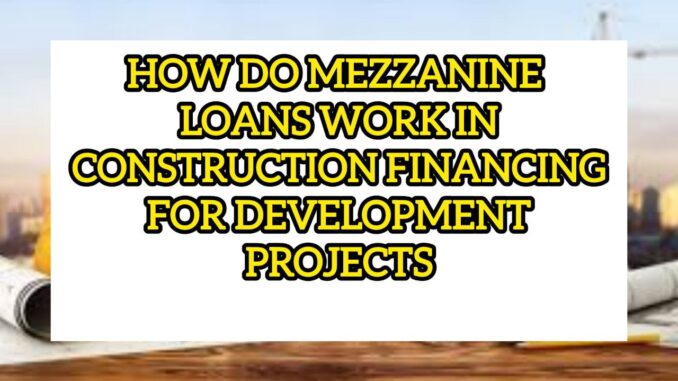
You ever wondered how ambitious real estate developers bridge the gap between senior loans and equity when financing their construction projects? Enter mezzanine loans—a financing tool that sits snugly between secured debt and equity, offering flexibility and speed. In this extensive exploration, we’ll break down everything you need to know about mezzanine loans in construction financing, from their role in the capital stack to real-world examples and exit strategies.
Understanding the Capital Stack in Construction
What Is the Capital Stack?
The capital stack is like a layered cake: each slice represents a different type of capital—senior debt at the bottom, mezzanine debt in the middle, and equity at the top. Just as you wouldn’t bite the icing before the sponge, lenders rank claims on cash flow and assets, with senior lenders paid first, mezzanine lenders next, and equity investors last.
Position of Mezzanine Debt
Mezzanine debt occupies a unique middle ground. It sits below senior loans (which have first claim on collateral) but above equity investors (who own the project). This positioning allows mezzanine lenders to demand higher returns than senior lenders, while offering developers cheaper capital than pure equity.
Defining Mezzanine Loans
Mezzanine loans are subordinate debt instruments that usually come unsecured or secured by the borrower’s equity interests rather than the property itself. Because they carry more risk than senior loans, mezzanine loans command higher interest rates—often expressed as LIBOR (or SOFR) plus a spread, plus potential equity participation in the form of warrants.
Why Developers Use Mezzanine Loans
Imagine you’re baking a cake but realize you’re short on flour. Instead of scrapping the recipe, you borrow just enough to finish baking. Mezzanine financing works the same way: when key senior lenders will only finance a portion of your total project cost—say, 65% to 75%—mezzanine debt fills the remaining gap, reducing the amount of equity you must inject.
Mezzanine vs. Senior Debt
Senior debt is typically secured by a first lien on the property and comes with the lowest interest rates. Senior lenders perform rigorous due diligence and restrict borrower actions through covenants. Mezzanine debt, being subordinate, accepts higher risk and higher returns but with more relaxed covenants. The trade-off? Mezzanine lenders rely on equity pledges, not property liens, making foreclosure more complex.
Mezzanine vs. Equity Financing
Equity investors inject capital into the project and share in profits but dilute the developer’s ownership percentage. Mezzanine debt, by contrast, preserves equity ownership—at least until a default triggers conversion rights or warrants. It’s akin to borrowing a power tool rather than selling part of your workshop.
Typical Terms of Mezzanine Loans
Interest Rates and Fees
Mezzanine loans often carry floating interest rates—LIBOR or SOFR plus spreads ranging from 5% to 12%. Additionally, borrowers may pay arrangement fees (1% to 3% of the loan amount) and exit fees upon maturity or repayment.
Equity Kickers and Warrants
To sweeten the deal, mezzanine lenders often receive warrants or rights to purchase equity at a predetermined price. This “equity kicker” aligns lender upside with project success, much like giving a friend tickets to your concert if they help cover your sound system costs.
Subordination and Security
Mezzanine debt is structurally subordinate to senior debt. Rather than a property lien, lenders may secure their position through pledge agreements over the borrower’s equity interests in the owning entity. In a default, mezzanine lenders typically foreclose on the equity, stepping into the shoes of the equity owner.
Structure of Mezzanine Financing
Mezzanine financing structures vary widely, but they usually include:
- Subordinated loan documents detailing payment priorities.
- Pledge agreements over equity interests.
- Intercreditor agreements between senior and mezzanine lenders, outlining rights, standstill periods, and foreclosure protocols.
These agreements prevent senior lenders from suddenly foreclosing and wiping out mezzanine lenders, and vice versa, maintaining a fragile peace in the capital stack.
Loan-to-Cost and Loan-to-Value Considerations
Lenders evaluate mezzanine loans based on Loan-to-Cost (LTC) and Loan-to-Value (LTV) ratios. If senior debt covers 70% LTC, mezzanine debt might top up another 10–15%, keeping total LTC below 85%. Similarly, combined loans (senior plus mezzanine) must respect a maximum LTV based on the project’s projected stabilized value.
Underwriting Process for Mezzanine Debt
Underwriting mezzanine finance involves evaluating the sponsor’s track record, project feasibility, and exit strategy. Lenders scrutinize:
- Developer experience: Have they delivered similar projects?
- Financial projections: Are cash flow forecasts realistic?
- Exit options: Sale, refinancing, or stabilized cash flow.
Because mezzanine lenders rely on equity foreclosure, they pay close attention to the developer’s reputation and ability to negotiate with senior lenders.
Role of Sponsors and Borrowers
Sponsors—or developers—must present a compelling case: robust market demand, feasible construction schedules, and seasoned general contractors. Borrowers usually provide personal or corporate guarantees and sometimes co-invest alongside mezzanine debt to demonstrate commitment.
Documentation and Covenants
Mezzanine loan documents include:
- Loan agreement: specifies amount, interest, maturity, and repayment terms.
- Pledge agreement: collateralizes equity interests.
- Intercreditor agreement: governs relationship with senior lenders.
- Covenants: financial covenants like Debt Service Coverage Ratio (DSCR) or project completion milestones.
Covenants tend to be looser than senior debt, but failures can trigger default and foreclosure on equity.
Risk and Return Profiles
Because mezzanine loans are riskier than senior debt, they offer returns in the mid-teens to high-teens percentage range. Equity kickers can boost returns if projects perform well, but defaults can wipe out returns entirely—similar to investing in a startup rather than a blue-chip stock.
How Mezzanine Loans Fill the Funding Gap
Senior lenders usually cap at 65–75% LTC to protect collateral value. Equity investors might contribute another 20–30%. Mezzanine debt sits between them, filling the delta of 10–15%. This gap-filling reduces equity dilution, preserving the developer’s upside while ensuring that funds are sufficient to complete construction.
Sources of Mezzanine Capital
Mezzanine financing comes from various sources:
- Specialty finance companies focusing on real estate debt.
- Private equity funds offering mezzanine debt alongside equity.
- Family offices seeking higher-yield fixed-income investments.
- Institutional debt funds structuring bespoke mezzanine facilities.
Each source has its own risk-return appetite and underwriting speed.
Preferred Equity vs. Mezzanine Debt
Some projects use preferred equity instead of mezzanine debt. Preferred equity sits even closer to equity in the stack and typically receives fixed dividends but has no amortization requirement. Mezzanine debt, however, usually amortizes or accrues interest, making it more debt-like in financial treatment.
Integration with Senior Construction Loans
Coordinating mezzanine financing with senior loans requires careful timing. Ideally, mezzanine commitments close after senior loan approval but before senior funding, ensuring that both pieces of the capital stack are in place. Intercreditor agreements then outline rights—such as standstill periods preventing mezzanine foreclosure while senior loan is in default.
Drawdown and Monitoring of Mezzanine Funds
Mezzanine loans may fund in tranches tied to construction milestones or upon senior draw completion. Lenders monitor progress via site inspections, budget reports, and senior lender reports. Failure to meet milestones can delay or reduce mezzanine disbursements, so clear communication and robust reporting are essential.
Common Use Cases in Development Projects
Residential Development
In multifamily or condominium projects, mezzanine debt often finances amenity build-outs—like parking garages or clubhouses—that senior lenders shy away from. This enhances project appeal without over-relying on equity.
Commercial Office Projects
Office conversions in urban cores often require expensive tenant fit-outs. Mezzanine loans fund these interior improvements, bridging the gap between shell funding and tenant improvement allowances.
Case Study: Residential Development
Imagine a developer planning a 200-unit apartment complex. The project costs $50 million. A senior lender offers 70% LTC ($35 million). Equity investors commit 20% ($10 million), leaving a $5 million shortfall. A mezzanine lender steps in with $5 million at SOFR+8%, plus warrants equal to 2% equity. This structure reduces equity dilution and ensures the project can proceed on schedule.
Case Study: Commercial Office Project
A developer converts a downtown historic building into coworking space at a cost of $30 million. The senior lender finances 65% ($19.5 million), and the developer invests 25% ($7.5 million). Mezzanine financing covers the remaining $3 million with a 12% interest rate and a 1.5% arrangement fee. The mezzanine loan funds tenant improvements, making the space attractive to high-end tenants and boosting stabilized value for refinancing.
Exit Strategies for Mezzanine Lenders
Mezzanine lenders plan exits carefully:
- Refinancing: Upon stabilization, a permanent lender pays off both senior and mezzanine debt.
- Sale: Proceeds from property sale retire the entire capital stack.
- Equity Conversion: In some cases, mezzanine lenders convert debt into equity upon default, becoming project owners.
Clear exit paths reassure mezzanine investors and provide developers with predictable endgames.
Managing Workouts and Defaults
If cash flow stumbles or construction overruns, mezzanine lenders may enter a workout with senior lenders. Intercreditor agreements spell out “standstill” and cure periods. During a workout, mezzanine lenders negotiate with both senior lenders and equity sponsors to restructure debt—often requiring additional equity or rate adjustments to keep the project afloat.
Impact of Market Conditions on Mezzanine Financing
Interest rate cycles, construction cost inflation, and market demand all affect mezzanine availability. In tight credit markets, spreads rise, covenants tighten, and lenders demand more equity kickers. Conversely, in low-rate environments, mezzanine financing can be more abundant and attractively priced.
Future Trends in Mezzanine Construction Finance
With technological advances and regulatory shifts, we’re seeing:
- Data-driven underwriting using AI to predict project success.
- Green mezzanine loans tied to sustainable building certifications.
- Blockchain-based pledge agreements for faster, more transparent security filings.
Staying ahead of these trends helps developers and lenders optimize structures and manage risk.
Conclusion
Mezzanine loans are powerful tools in construction financing, filling critical funding gaps and preserving developer equity. By understanding their position in the capital stack, typical terms, underwriting processes, and exit strategies, you can leverage mezzanine debt to bring complex development projects to life. Whether you’re a seasoned sponsor or a first-time borrower, mastering mezzanine financing opens doors to new opportunities—and new levels of profitability.
FAQs
Are mezzanine loans always necessary in construction financing?
Not always. If senior lenders will finance a higher percentage of costs or if you have sufficient equity, mezzanine loans may be unnecessary. However, for ambitious projects with tight senior caps, mezzanine financing can bridge critical gaps.
How does a mezzanine lender get repaid if the project fails?
Mezzanine lenders rely on equity pledges rather than property liens. In default, they foreclose on the borrower’s equity interest, taking ownership of the project company. This process can be more complex than senior foreclosure but offers a path to recovery.
Can mezzanine financing be combined with preferred equity?
Yes. Some developers use a blend of mezzanine debt and preferred equity to optimize leverage and cost of capital. Preferred equity sits closer to equity and may carry fixed dividends instead of interest.
How long do mezzanine loans typically last?
Mezzanine loans generally have maturities of 2 to 5 years, aligned with construction and stabilization timelines. Extensions may be negotiated, often at higher rates or with additional equity participation.
What happens if interest on a mezzanine loan is deferred?
Deferred interest accrues and compounds, increasing the payoff amount at maturity. While this eases cash flow during construction, it raises total financing costs and can impact exit strategies.

West is both an engineer and a construction manager with a solid ten-year track record in directing building projects and managing their financial aspects. Throughout his career, he has honed his skills in coordinating multidisciplinary teams, streamlining budget processes, and structuring financing plans that ensure projects are delivered on time and within financial targets.
Leave a Reply